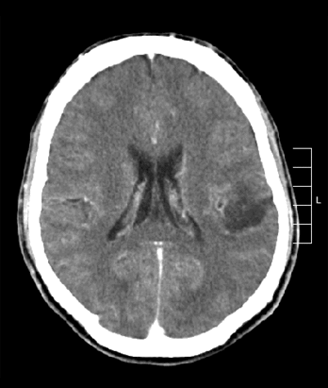Two Distinct Subtypes of Pediatric Glioma Identified
Researchers have identified two genetic characteristics that may distinguish pediatric secondary high-grade glioma from primary high-grade glioma.
Glioma of the left parietal lobe, CT scan with contrast enhancement; source: Ninilak, Wikimedia Commons

Researchers have identified two genetic characteristics that may distinguish pediatric secondary high-grade glioma (sHGG), results of a new study indicated.
Matthew Mistry, MSc, of the Hospital for Sick Children in Toronto, and colleagues conducted a retrospective study of patients with sHGG and discovered that BRAF V600E mutations and CDKN2A deletions distinguished sHGG from primary HGG, and occurred less commonly in patients with pediatric low-grade glioma (PLGG) that did not transform into high-grade disease.
“Our study reveals additional molecular and genetic differences between childhood and adult gliomas,” the researchers wrote in the Journal of Clinical Oncology. “Common alterations found in adult low-grade gliomas that transform such as ATRX, IDH1, and ALT were extremely rare in our cohort, whereas BRAF V600E, H3.3, and hTERT promoter mutations, which are uncommon in adult sHGG, were highly enriched in our cohort.”
Mistry and colleagues retrospectively looked at 886 patients with PLGG from a population-based cohort and identified 26 (2.9%) with sHGG. They performed exome sequencing and array comparative genomic hybridization on tumor samples from these patients to identify genetically distinct subgroups of patients.
The researchers found that patients with sHGG had a median of 25 total somatic mutations, a load considerably higher than that found in primary pediatric HGGs (median of 11 mutations), according to previously published studies.
The most commonly recurrent alterations were BRAF V600E, which occurred in 39% of sHGGs, and CDKN2A, which occurred in 57% of sHGGs. All of the BRAF V600E mutations and 80% of the CDKN2A alterations could be traced back to their PLGG counterparts.
“To determine whether these early events are unique to this subset of pediatric gliomas, we compared the frequency of these alterations to nontransformed PLGG and primary pediatric HGG,” the researchers wrote. “BRAF V600E was significantly enriched in PLGG that transformed, being present in 44% (8 of 18) of PLGGs that transformed compared with 6% (10 of 167) of PLGGs that did not transform. …CDKN2A deletions were significantly enriched in PLGG that transformed (71% vs 20% of PLGGs that did not transform).”
The researchers also found that PLGG with BRAF mutations took longer to transform to sHGG than wild-type PLGG. In addition, the 5-year overall survival rates of children with BRAF-mutant PLGG that transformed was 75% compared with 29% in children with wild-type PLGG that transformed (P = .024), possibly providing “an opportunity for surgical interventions, surveillance, and targeted therapies to mitigate the outcome of sHGG,” the researchers wrote.
In an editorial that accompanied the research, Alberto Broniscer, MD, of St Jude Children’s Research Hospital and the University of Tennessee Health Science Center in Memphis, called the identification of these two markers “exciting.”
Broniscer also pointed out a few limitations to the research as well. Mistry and colleagues included some tumors that were not histologically confirmed to be LGGs or HGGs, adding that “clinical and radiologic characteristics alone cannot unequivocally identify transformation from LGG to HGG.” In addition, he noted that 31% of patients experienced malignant transformation of their tumors relatively quickly, indicating that the original tumor sample may not have been taken from the most aggressive region of the tumor and that the primary tumor may have been high grade.
“These results must be validated in a larger cohort of patients,” Broniscer wrote. “Similar to adult tumors, the availability of tumor tissue collected at different time points from geographically distinct areas may provide a better understanding of the heterogeneity and clonal evolution of these tumors.”